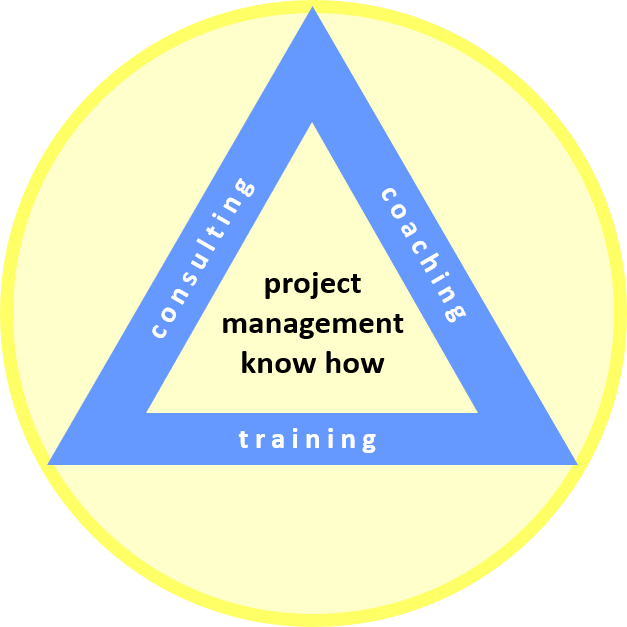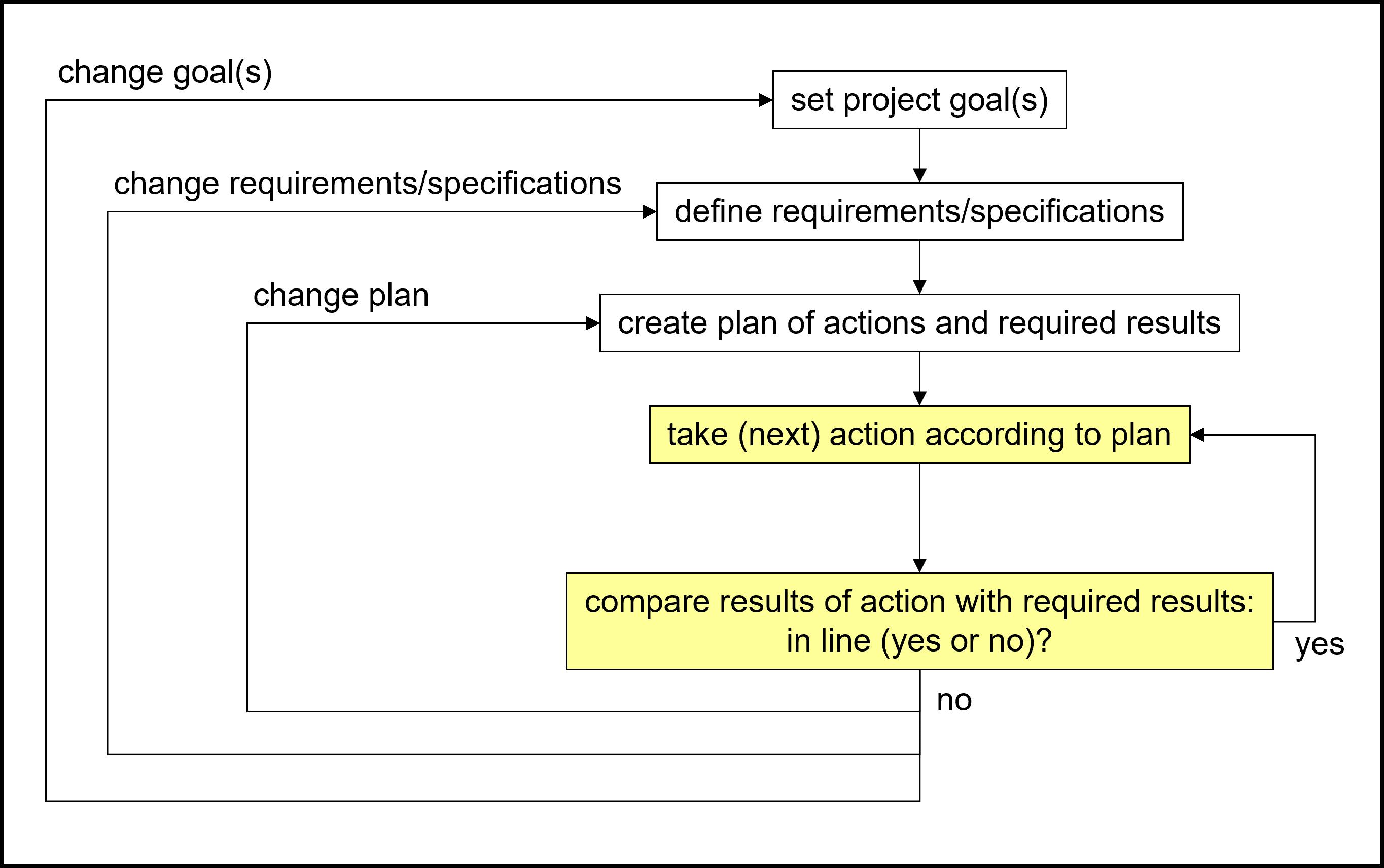- Home
- Implementation
Project Implementation
Published: 2009-03-15
Last updated: 2022-03-16
In project implementation or project execution, we put it all together. Project planning is complete, as detailed as possible, yet providing enough flexibility for necessary changes. In a customer-contractor relationship, the contract is signed, based on the right decisions about the contract structures, and including clauses for change and claim management.
Now we apply all the tools we prepared in order to keep ourselves in control of the project. As project managers and sub-project managers we have to make sure that we, together with all our team members,
- take action, in-line with the plan and / or contract
- record and document all the work, work results, special events, decisions about changes, implementation of changes, etc.
- analyze, communicate, report, and document status and results of action, in-line with the plan and / or contract
- take decision if and what kind of change we need, in case any result (or action) is not as required
- implement agreed changes, in-line with the plan and / or contract.
In project implementation, we manage the execution of all our project plans, following the triple constraint:
- Project Scope Management
- Project Time Management
- Project Cost Management
In the implementation and closure phase, our focus will be on the comparison of actual results with required results.
The most powerful platform for this comparison to analyze,
communicate and decide work progress, problems, and necessary changes
are project meetings in which we apply the planned project controlling
tools.
- kick-off meetings
- regular status meetings
- special status meetings
- risk analysis workshops (as part of our risk management strategy)
- problem-solving workshops
- project management review meetings
In the section Free Downloads, you find a checklist for meetings.
Kick-off meetings
In project planning, we assigned all necessary resources to the project. We continuously reassured that those resources are still available and ready to take off. Now is the right time to have the project kick-off meeting. Its main purpose is to present the project planning status to the stakeholders, especially to all our team members, and to officially start project implementation phase.
This kick-off meeting at the beginning of implementation phase triggers other meetings and workshops:
- workshop for the handover from the proposal team to the implementation team (in projects with a customer-contractor relationship)
- contract analysis workshop (in projects with a customer-contractor relationship)
- engineering or design review meetings (for the product that has to be created)
A typical agenda of a project kick-off meeting could look like this:
- Introduction of participants and agenda
- Presentation of project goal(s), PBS, and WBS
- Presentation of planning milestones and over-all project schedule
- Presentation of project cost structure
- Assignment of responsibilities
- Commitment of team members
- Agreement on minutes of meeting and conclusion
Regular project status meetings
To keep track of the results achieved, we hold regular status meetings throughout project implementation and closure phases. The frequency of these regular status meetings depends on the project duration, e.g. every week for a project of 20 to 40 weeks duration, or every 2 weeks for a project of 50 to 80 weeks duration. A typical agenda could look like this:
- Introduction of the agenda
- Status of sub-projects and milestones (MTA)
- Earned value analysis (EVA)
- Status of changes
- Discussion and decisions
- Agreement on minutes of meeting and conclusion
Special project meetings
Any event or arising problem in project implementation that disturbs the planned and regular work progress triggers a special project meeting. These special meetings focus only on the event that happened or the problem that came up. Most of these events or problems should be on our risk list. However, there will still be some which we do not have on our radar screen but could jeopardize the project or major parts of it, and hence, need to be discussed. A typical agenda of such a special project meeting could look as follows.
- Introduction of the agenda
- Report about the event that triggered the meeting
- Comparison with risk list (is the event on our risk list?)
- Consequences if nothing would be done: what is the impact?
- Planned action(s) according to earlier risk analysis
- What other action(s) are required or can be done?
- Update risk list
- Discussion and decisions
- Agreement on minutes of meeting and conclusion
Risk management workshops
Following our risk management process, we repeat risk management workshops regularly, throughout the whole project management process. The typical agenda of such a risk management workshop could look as follows.
- Introduction of the agenda
- Status of risk events: which events occurred, which did not occur?
- Revision of the risk list: what new risks can be anticipated, which risks cannot occur anymore?
- Evaluation of new risks: probability, impact
- Identify preventive or corrective actions, etc.?
- Update risk list
- Discussion and decisions
- Agreement on minutes of workshop and conclusion
Problem solving workshops
In case of any serious problem occurring in project implementation that affects the whole project or major parts of it we hold a problem solving workshop. These workshops follow the general problem solving process:
- Introduction of the agenda
- Define the problem
- Analyze the problem: causes and impact
- Brainstorming on possible solutions
- Plan actions
- Discussion and decision
- Agreement on minutes of workshop and conclusion
Project management review meetings
On a regular or non-regular basis, we hold project review meetings. There are three types of review meetings:
- The project management team calls for a review meeting in order to have somebody from outside the team carry out a health check of project implementation (non-regular).
- The control board calls for a review meeting in order to obtain an overview of the project status (regular).
- The customer calls for a review meeting in order to obtain an overview of the project status (regular).
Usually, those who call for the review meeting setup the agenda as well. In case (A), where the team asks for a project health check, we typically follow an agreed project assessment procedure. For control board and customer driven review meetings, we generally apply this agenda:
- Introduction of the agenda
- Project status: Milestone Trend Analysis, Earned Value Analysis, major achievements, major problems
- Suggested solutions of problems
- Further steps and actions
- Discussion and decisions
- Agreement on minutes of workshop and conclusion
Project management reports
Further backbones of successful project controlling during project implementation are well structured and regular project management reports. In most cases, these reports will serve as an excellent basis for the project meetings and workshops. Good reports also help to keep those meetings and workshops short and efficient. For projects with virtual team work, they are vital.
The project management reports follow the communications plan. In the section Free Downloads, we offer some useful templates for project status reports, risk analysis reports, problem reports, and others. We feed their essential data into our project management dashboard.
Project Records
In project implementation, we need to monitor everything that could jeopardize our project or parts of it.
As emphasized in the section about Contract Management, it is essential to take records of anything that is not in-line with the contract. Only then we are able to follow the change management process or the claim management process.
In case everything runs smoothly, according to plan, we also keep records of the achieved work progress since only this ensures timely update of our milestone trend analysis and earned value analysis (if we apply earned value project management, sometimes simply referred to earned value management).
If something is not in line with our project plans, i.e. an event happens that has serious consequences on our project or parts of it, we need to take all available records of that event, of its impact, of all possible solutions found in co-operation with the customer, sub-suppliers, or other stakeholders, and of the decisions made in order to solve the problem. Here, you find what counts as project records.
Should we encounter a situation where we have to pursue a claim we enter the contractual claim process and settlement procedure as early as possible in order to decrease pressure in project closure phase. For further details, please refer to sub-section Project Claim Management and to a case study in sub-section Project Claim Analysis.
Application of controlling tools
All data and information we obtain from records and project meetings go into those controlling tools we prepared in planning phase. The set of controlling tools we chose earlier, now forms our system of project management metrics. Application of two of those tools we explain more detailed:
- Milestone Trend Analysis (MTA), in sub-section Milestone Trend Analysis;
- Earned Value Analysis (EVA), in sub-section Earned Value Project Management.
We present MTA and EVA within our project management reports, and feed their essential data into our project management dashboard.
Project Termination
Amongst the most serious decisions a project management team and its control board have to take is project termination. Such a decision usually implicates frustration for those stakeholders who sincerely believed - and in most cases still believe – that the project could produce the results they expected – or still expect. What can we do to avoid those negative consequences? Please, refer to sub-section Project Termination to pick-up our suggestions.
Conclusion of project implementation phase
Towards the end of project implementation phase, the desired result of the project takes more and more shape: we integrate, test, and commission last sub-parts. The end product or service is essentially put together. Then, we declare the project result "ready for preliminary acceptance". In a contractual based relationship between customer and supplier, the declaration of preliminary acceptance by the customer is usually accompanied by a List of Open Points (LoP). This LoP covers minor issues that are not yet fully compliant with the requirements or specifications, and have to be resolved in closure phase. Preliminary acceptance concludes project implementation phase.
35+ templates, tools, and checklists in one set
To save you time in your daily work as a project manager, I packaged more than 35 project management templates, tools, and checklists into one zip file.
- You un-zip it, and you get all items in formats you can edit to your requirements.
- They strictly contain only standard functionality and no macros or other code.
- You are allowed to use your logo.
or click here for more info.
Traditional PM
Learning Path Navigation
|
|
|
Return from Project Implementation to Home Page
|
|
|



Your Comments
Have your say about what you just read! Leave me a comment in the box below.